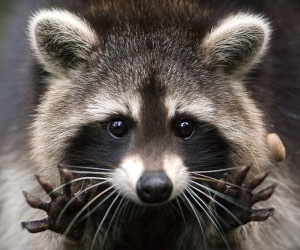 Raccoons (Procyon lotor) have been a part of our livelihood and pop culture for a while – Meeko was Pocahontas’s faithful sidekick; Rocket Raccoon is one of the Guardians of the Galaxy; anyone who’s played Nintendo’s hit game Animal Crossing has a love/hate relationship with the raccoon shop keeper, Tom Nook; and what child hasn’t begged their parents for a subscription to Ranger Rick to learn all about nature’s coolest animals?! Equally described as “cute” and a pest, these furry bandits are a common sight here in Colorado.
Raccoons (Procyon lotor) have been a part of our livelihood and pop culture for a while – Meeko was Pocahontas’s faithful sidekick; Rocket Raccoon is one of the Guardians of the Galaxy; anyone who’s played Nintendo’s hit game Animal Crossing has a love/hate relationship with the raccoon shop keeper, Tom Nook; and what child hasn’t begged their parents for a subscription to Ranger Rick to learn all about nature’s coolest animals?! Equally described as “cute” and a pest, these furry bandits are a common sight here in Colorado.
“Ain't no thing like me, except me!” – Rocket Raccoon
Now speaking as a genetically engineered raccoon, I’m sure it’s safe to say that Rocket is probably right. However, for the non-genetically engineered raccoons found here in Colorado, that’s only partially true. Raccoons fall within the family procyonidae which is a group of medium sized mammals that usually have pointed noses. We can find two different species from the family procyonidae here in Colorado: ringtails and raccoons. For those of you that may not have seen a ringtail, imagine putting a raccoon through a stretcher and taking away the bandit mask. TaDa! Ringtail. People originally thought that raccoons were closely related to dogs which is how they got their scientific name Procyon which comes from the Greek for “before dog” while lotor means “one who washes.” Not that the raccoon actually washes their food. Their front paws are very dexterous, and they’re often seen foraging for food in and around waterways which has lead people to believe that the raccoon is a bit of a germaphobe.
“One man’s garbage is another man’s treasure. Unless you’re a raccoon. Then it’s basically all one category.” -- Unknown
Raccoons are not known to be very discerning when it comes to food. These furry bandits will eat anything they can get their paws on. From foraging for food in streams and ponds, to eating fruits and nuts, to the ever famous garbage can; raccoons will eat just about everything which makes them one of the most omnivorous animals in the world. So when you use bear resistant trash cans to help bears stay wild, you’re also helping our friend the raccoon stay wild as well.
About this time of year, the snow starts to melt, the days get longer, and our friend the raccoon starts to prepare for the next generation. After a 65-day gestation period, a female raccoon gives birth to two to five kits. The kits will stay in the den with their mother for about 8-10 weeks before they venture out with her to learn to forage. Mother raccoons are very protective of their young and will attack predators that come too close. These young will stay with their mother for about a year, learning the tricks of being a raccoon.
During the summer and fall, raccoons will continue to forage and gain weight for the coming winter. They are usually nocturnal, but it’s not uncommon to see them during the day. They are often seen in wooded areas next to water, although they’re highly adaptable to living in a suburban or even city environment.
Once winter comes, raccoons stay active as long as the temperatures don’t dip too low. During cold snaps, they can stay in their dens for long periods of time living off the fat they gained during the summer and fall. Watch for raccoons this spring as the weather warms and they become more active, but like any wild animal, do not approach or feed them; raccoons may be cute, but they can be dangerous if cornered or threatened.
Laura Woodward is a naturalist at Walking Mountains Science Center in Avon who has loved raccoons ever since one jumped into the passenger seat of her family’s 1987 Suburban on a childhood vacation to Colorado.









